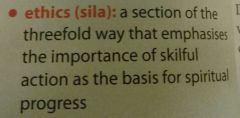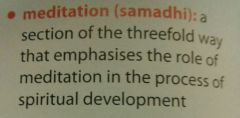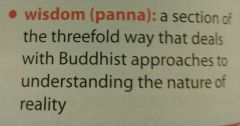![]()
![]()
![]()
Use LEFT and RIGHT arrow keys to navigate between flashcards;
Use UP and DOWN arrow keys to flip the card;
H to show hint;
A reads text to speech;
50 Cards in this Set
- Front
- Back
|
Buddhism |
A religion founded around 2500 years ago by Siddhartha Gautama |
|
|
Buddha |
A title given to someone who has achieved enlightenment usually used to refer to Siddhartha Guatama |
|
|
The four sights |
Old age, illness, death and a holy man; these four sighs led the Buddha to leave his life of luxury in the palace |
|
|
Jataka |
The Jataka tales are popular stories about the lives of the Buddha |
|
|
Ascetic |
Living a simple and strict lifestyle with few pleasures or possessions; someone who follows ascetic practises. |
|
|
Meditation |
A practise of calming and focusing the mind and reflecting deeply on the specific teachings to penetrate their true meaning. |
|
|
Enlightenment |
The gaining of true knowledge about God, self or the nature of reality, usually through meditation and self-discipline; in Buddhist, Hindu and Sikh traditions, gaining freedom from the cycle of rebirth. |
|
|
Mara |
A demon that represents spiritual obstacles, especially temptation. |
|
|
The three watches of the night |
The three realisations that the Buddha made in order to achieve enlightenment |
|
|
The five ascetics |
The Buddha's first five students; five monks who followed ascetic practises |
|
|
Dhamma (dharma) |
The Buddha's teachings |
|
|
Pali |
The language of the earliest Buddhist scriptures |
|
|
Pali |
The language of the earliest Buddhist scriptures |
|
|
Pali |
The language of the earliest Buddhist scriptures |
|
|
Sanskrit |
The language used in later indian Buddhist texts |
|
|
Dependant arising |
The idea that all things arise in dependence upon conditions |
|
|
The Tibetan Wheel of Life |
An image that symbolises samsara, often found in Tibetan Buddhist monasteries and temples |
|
|
Nidanas |
12 factors that illustrates the process of birth, death and samsara |
|
|
Samsara |
The constant cycle of birth, life, death and rebirth |
|
|
Kamma (karma) |
A person's actions; the idea that skilful actions results In happiness and unskilful ones result in suffering |
|
|
Nirvana (nibbana) |
A state of complete enlightenment, happiness and peace |
|
|
Dukkha |
The first noble truth; there is suffering |
|
|
Anicca |
Impermanence the idea that everything changes |
|
|
Anatta |
The idea that people do not have a permanent, fixed, self or soul |
|
|
The five aggregates |
The five aspects that make up a person. Form, sensation, mental formation, conscience and perception. |
|
|
The Four Noble Truths |
The four truths the Buddha taught about suffering |
|
|
Dukkha |
The first noble truth: there is suffering |
|
|
Samudaya |
The second noble truth: there is a cause for suffering |
|
|
Nirodha |
The third noble truth: suffering can be stopped |
|
|
Magga |
The fourth noble truth: the way to stop suffering: the Eightfold Path |
|
|
Theravada Buddhism |
'The school of the elders'; an ancient Buddhist tradition found in southern Asia |
|
|
Mahayana Buddhism |
An umbrella term used to describe later Buddhist traditions, including Pure Land Buddhism, Tibetan Buddhism and Zen Buddhism |
|
|
Tanha |
Craving (desiring or wanting something) |
|
|
The Three Poisons |
Ignorance, hatred and greed. The main causes of suffering |
|
|
Nibbana (nirvana) |
The state of complete enlightenment, happiness and peace |
|
|
The EightFold Path |

|
|
|
The threefold way |

|
|
|
Ethics (sila) |

|
|
|
Meditation (samadhi) |

|
|
|
Wisdom (panna) |

|
|
|
Theravada Buddhism |
'The school of the elders': an ancient Buddhist tradition found in southern Asia |
|
|
Mahayana Buddhism |
An umbrella term used to describe some later Buddhist traditions including Pure Land Buddhism, Tibetan Buddhism and Zen Buddhism. |
|
|
Sunyata |
Emptiness; the concept that nothing has a seperate independent fixed self or soul |
|
|
Buddha-nature |
The idea that everyone has the essence of Buddha inside of them |
|
|
Buddhahood |
When someone achieves enlightenment and becomes a Buddha |
|
|
Arhat |
For Theravada Buddhists, someone who has become enlightened |
|
|
Bodhisattva |
For Mahayana Buddhists, someone who has becomes enlightened but chooses to remain in thr cycle of samasara to help others achieve enlightenment as well |
|
|
Pure Land Buddhism |
A Mahayana form of Buddhism based on the belief on Amitabha Buddha |
|
|
Amitabha Buddha |
The Buddha worshipped by Pure Land Buddhists |
|
|
Sukhavati |
The paradise where Amitabha Buddha lives, and where Pure Land Buddhists aim to be reborn |

